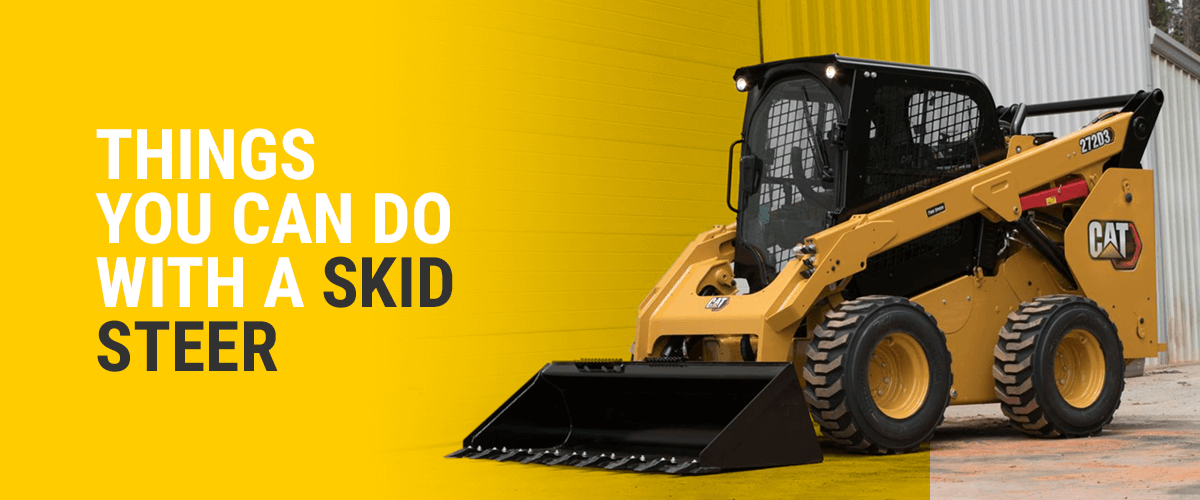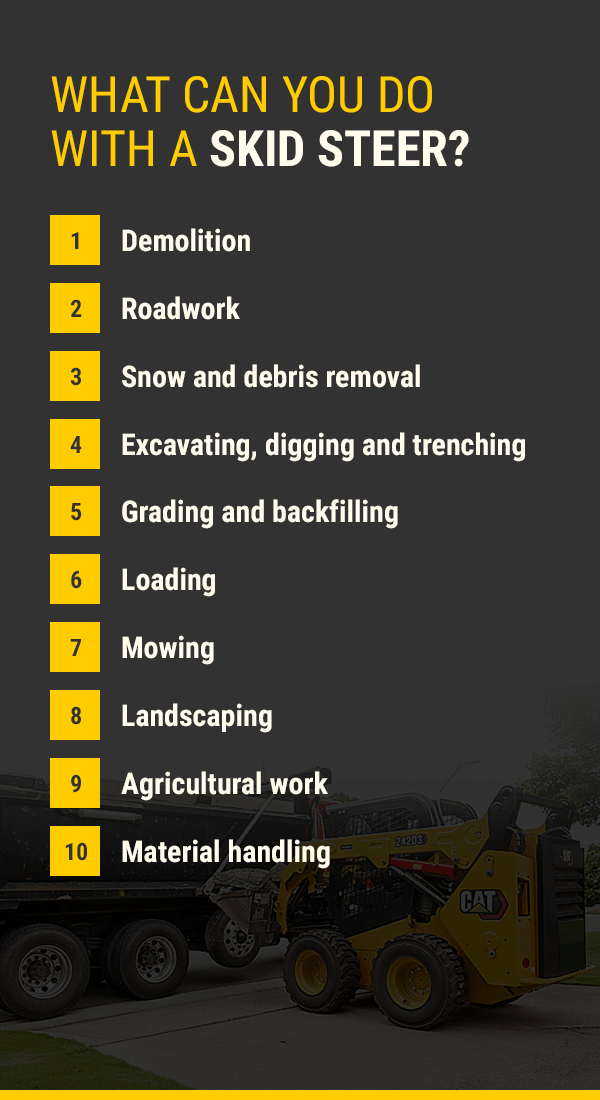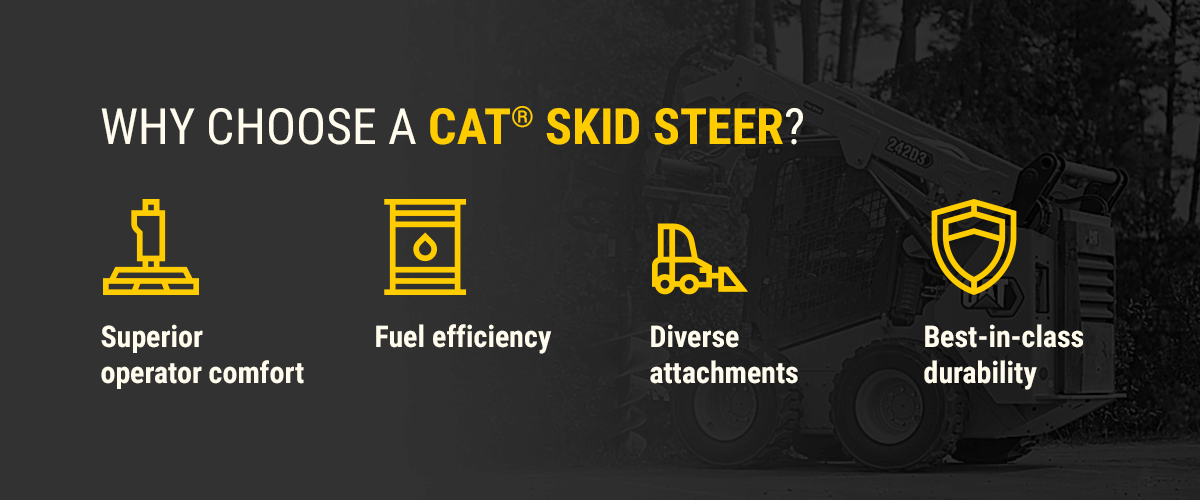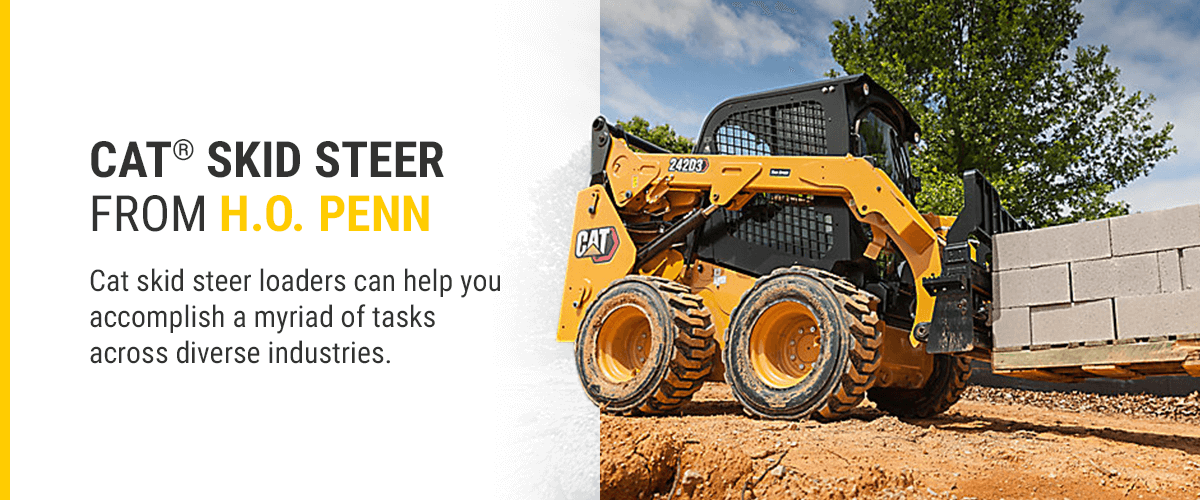
Jump To Sections:
- What Is a Skid Steer?
- Skid Steer Size Guide
- What Is A Skid Steer Used For?
- Renting vs. Buying a Skid Steer
- Why Choose a Cat® Skid Steer?
- Cat Skid Steers From H.O. Penn
In 1957, two brothers invented the first version of the skid steer loader to help clean out a turkey barn. Today, skid steer loaders are popular pieces of heavy equipment that can do a lot more than just clean out barns. With a host of attachments to choose from, a skid steer loader can take on a long list of jobs in construction, landscaping, agriculture and material handling.
What Is a Skid Steer?
A skid-steer loader, or skid steer for short, is a small construction vehicle used for a variety of tasks. Skid steers typically include a bucket as the default attachment, but you can outfit them with many different attachments, allowing skid steers to assist with all sorts of construction and landscaping projects. Skid steers also come in a variety of sizes to suit different applications. Even for jobs that don’t call for a lot of heavy construction equipment, a skid steer can help you get the job done more efficiently.
The skid steer gets its name from the way it turns. The angle of the wheels or tracks is fixed, so they will only point straight ahead. The wheels or tracks on each side of the vehicle are locked in synchronization with each other and have their own engines. This means you have to steer each side independently from the opposite side.
Because the wheels are fixed, you cannot steer by angling the wheels in a different direction. Instead, you steer by speeding up either the left or right side of the vehicle, causing the wheels to drag — or skid — across the ground as the skid steer turns. This type of steering is known as differential steering, and it allows you to make zero-degree radius turns, a helpful feature in tight spaces and when the task calls for precision. Of course, the driver must be trained or experienced in differential steering to operate the skid steer.
Skid Steer Size Guide
If you’re interested in using a skid steer on your job site, you’ll want to choose the size that makes the most sense for you. All skid steers are relatively small compared to some other types of heavy equipment, but you can still purchase or rent skid steer loaders in a range of sizes. The size of a skid steer refers to the size of the frame, plus the weight, power and capacity.
For instance, Caterpillar currently offers eight skid steer models, ranging in operating weight from 5,849 to 9,573 pounds. These models also range in their horsepower, with larger models offering more horsepower than smaller models. Another important metric is the rated operating capacity (ROC). The ROC tells you how heavy of a load a skid steer can lift without tipping. The smallest Cat® skid steer can safely lift 1,550 pounds, while the largest one comes with an ROC of 3,700 pounds.

You’re probably wondering, what size skid steer do I need? The answer depends on your intended applications. Here are some advantages that each size category offers:
- Small: If you want a skid steer for jobs in tight spaces, like interior demolition or underground construction or for precision work like landscaping, you may want to choose a skid steer with a small frame. Smaller skid steer loaders are lighter, making them easier to transport to and from the job site and easier to maneuver on the job.
- Mid-size: A mid-size skid steer is a good, versatile option that is still fairly small and light while offering more power and capacity than a small skid steer. With the right attachments, these skid steers can be an excellent tool for digging in tight areas where a larger piece of equipment, like a backhoe, wouldn’t fit.
- Large: Large skid steers are the best option for heavy-duty applications like large-scale demolition projects, excavation work and roadbuilding. A large skid steer will still be smaller than many other common pieces of construction equipment, but compared to smaller skid steers, large skid steers are heavier to haul and not as good at maneuvering through tight spaces.
What Is a Skid Steer Used For?
What are skid steers used for? A lot. Skid steers can help with a wide range of tasks. Here are some examples of jobs that a skid steer can help you accomplish:
- Demolition: Skid steers work great for both interior and exterior demolition projects. With demolition shears, your skid steer can help demolish flooring, concrete, drywall and other materials. Because of its compact size and precision, a skid steer is especially valuable for demo projects in tight spaces, such as when you’re tearing down a house in a neighborhood with other houses nearby.
- Roadwork: Skid steers can perform road building and maintenance tasks. You can attach a cement mixer or pavement miller to your skid steer and use other attachments for tasks like demolition, grading, paving and patching.
- Snow and debris removal: You can use the bucket attachment on your skid steer to clear snow and other debris, such as brush. You can also get a snowblower or snow blade attachment if you use your skid steer for serious snow removal.
- Excavating, digging and trenching: A skid steer is great for earthmoving tasks like digging, trenching and excavating. There are a variety of attachments you can use for these tasks, depending on your specific needs. Some examples include a backhoe, auger, trencher and wheel saw. With the right attachment, a skid steer can dig anything from a whole foundation for a building to narrow portholes.
- Grading and backfilling: You can also fill in holes, level out the ground and aerate it with a skid steer. You can use a bucket for these tasks, but a rake attachment or a grading bar works even better when you’re leveling. With these attachments, you can also scoop up rocks while you level the ground without leaving big trenches behind. For work that is low to the ground, you can use a radial lift skid steer rather than a vertical lift.
- Loading: Skid steers can help you carry equipment and materials around the job site using a bucket attachment. If you need to lift materials, you may want to consider a vertical lift rather than a radial lift skid steer since these models can lift heavier loads and achieve a higher reach.
- Mowing: You may be surprised to know you can also use a skid steer to mow. With a rotary brush cutter, you can cut down tall grasses and other growth to efficiently clear an area. You may even be able to cut down some smaller trees. Because skid steers are zero-turn, they offer the precision you need for mowing but with more abilities than a typical riding mower.
- Landscaping: Some of the tasks we’ve already looked at are useful for landscaping. Other examples of landscaping tasks you can accomplish with a skid steer are grinding stumps, chipping wood and tilling. You can even use a tiller attachment to help mix in compost or fertilizer into the soil. With a bucket, you can transport materials like gravel or mulch or landscaping tools you would otherwise have to push in a wheelbarrow.
- Agricultural work: Skid steers can also be highly useful for farm work. You can use them for tilling and other tasks we’ve already mentioned. Plus, you can use a bucket attachment to clean out barns and stables. You can even purchase a bale attachment to move bales of hay — a task that can otherwise be labor-intensive.
- Material handling: Skid steers can also be useful in a warehouse. With a fork attachment, you can move pallets and other materials. If you want a skid steer for lifting materials and placing them in a warehouse, you’ll want to opt for a vertical lift rather than a radial lift option.

These are some skid steer applications, but this list is not exhaustive. There are so many things that you can use a skid steer for as long as you have the right attachment for the job.
Renting vs. Buying a Skid Steer
Once you realize all the ways a skid steer can help you, you may turn your attention to how you can get your hands on one. There are two main options to consider: buying or renting. There are advantages to buying vs. renting skid steers and vise versa. Let’s look at some pros and cons of both renting and buying, so you can make an informed decision.
Renting
Generally, if you don’t use a piece of equipment on a regular basis, you should think about renting. There are other considerations, though. If you find you keep having to rent the same piece of equipment, you could end up spending more on rental costs than you would to just purchase the equipment. Buying is an investment, so the question is, will that investment pay off in the end? If not, then renting is a great option.
Renting also allows you to choose the skid steer that best fits your application at the moment. That means you could choose a larger, vertical lift skid steer for one job and then, the next month, rent a small, radial lift skid steer for a different job. The same principle applies to attachments. Some attachments are very multi-purpose, and you may get a lot of use out of them, but for some specialty tasks, you may prefer renting the ideal attachment for the job.
Finally, renting can be a good option if you take on out-of-town jobs and don’t want to haul your equipment there. Instead, you can just rent equipment near the job location. However, when it comes to a skid steer — especially smaller ones — transporting them is fairly easy compared to other types of heavy equipment.
Buying
If you think you’ll get a lot of use out of a skid steer, then buying is a good option to consider. You may want to try a longterm rental, so you can get an accurate idea of how often you use your skid steer. If your skid steer becomes a staple piece of equipment on the job, then you should think about purchasing one. When you’re buying, though, choosing the right skid steer is critical, so pay attention to your needs and ask your dealer for advice.
When it comes to more specialty equipment, renting is a smart move — but, because skid steer loaders are so multifaceted and can accomplish so many different tasks, this is one of the machines you should strongly consider buying. You may want to buy the skid steer itself and some essential attachments, then rent other attachments you need for various jobs as needed.
Buying a piece of heavy equipment is an investment. It may seem like more of a financial commitment than renting, but if it allows you to work more efficiently and avoid repetitive rental fees, you can get a great return on your investment over time. Plus, skid steers generally have lower initial costs and ongoing costs than other similar types of compact equipment.
Why Choose a Cat® Skid Steer?
Whether you choose to buy or rent, you should choose a skid steer from a brand you can trust. Caterpillar has been producing innovative, high-quality heavy equipment for a century, and they continue to be leaders in the heavy equipment market, putting out top-of-the-line skid steers and other equipment. New Cat skid steer models feature cutting-edge technology and other desirable features, including:

- Superior operator comfort: Cat skid steer loaders come with impressive visibility and precision controls, making for easy operation. They also offer more room in the cab for the operator than older models, making for a more comfortable experience inside.
- Fuel efficiency: Caterpillar is committed to manufacturing equipment with great fuel efficiency and minimal emissions. All their current skid steer loaders are EPA Tier 4 Interim compliant. The more efficient your skid steer loader is, the less you’ll have to spend on fuel.
- Diverse attachments: Caterpillar has expanded its tooling offerings so you can always find the right attachment for the job. These attachments are also easy to change out, so you can repurpose your skid steer quickly and keep working. The most convenient option is to add a hydraulic coupling system, which allows operators to switch tools right from the cab.
- Best-in-class durability: Caterpillar puts all its machines through rigorous testing to ensure they’re able to withstand harsh conditions and keep functioning effectively. Cat skid steers are some of the toughest you’ll find, so with the necessary ongoing maintenance, you can rely on them to perform.
Cat Skid Steers From H.O. Penn
Cat skid steer loaders can help you accomplish a myriad of tasks across diverse industries. With so many skid steer uses, you may want to consider including this handy piece of equipment at your next job site.
If you’re located in lower New York or Connecticut, H.O Penn Machinery is your exclusive provider of Cat skid steer loaders. You can rent skid steers from H.O. Penn or buy a new one to add to your equipment fleet. To learn more about our product offerings and how we can help you, contact us online or give us a call at (845) 448-0018. You can also stop by one of our locations in Holtsville, Bronx, Newington, Poughkeepsie, Bloomingburg and Medford.

